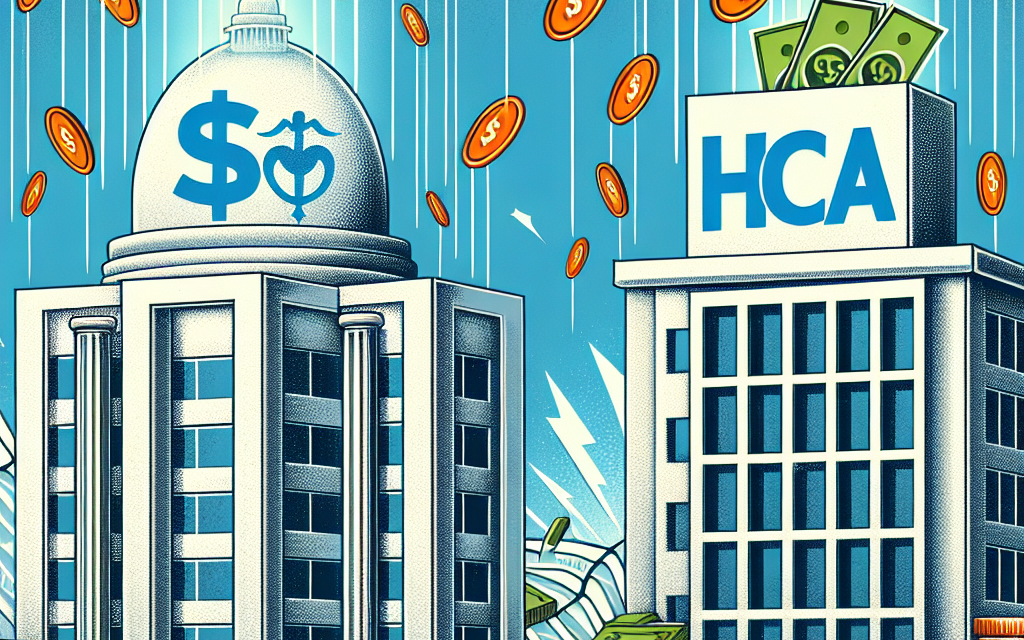UHS and HCA May Benefit Financially from Increased State-Directed Medicaid Payments

The healthcare industry in the United States is a complex ecosystem, with various stakeholders including hospitals, insurance companies, and government programs like Medicaid. Universal Health Services (UHS) and Hospital Corporation of America (HCA) are two major players in this field. Both organizations stand to benefit from increased state-directed Medicaid payments, a development that could have significant financial implications. This article explores the potential benefits for UHS and HCA, examining the broader context of Medicaid, the financial landscape of these healthcare giants, and the impact of state-directed payments.
Understanding Medicaid and State-Directed Payments
Medicaid is a joint federal and state program that provides healthcare coverage to low-income individuals and families. It is a crucial component of the U.S. healthcare system, offering services to millions of Americans who might otherwise lack access to necessary medical care. State-directed payments are a mechanism through which states can direct additional funds to healthcare providers, often to support specific policy goals or address disparities in healthcare access.
State-directed payments are designed to enhance the quality of care, improve access, and ensure that healthcare providers are adequately compensated for the services they deliver to Medicaid beneficiaries. These payments can take various forms, including supplemental payments, incentive payments, and value-based payments. The flexibility of state-directed payments allows states to tailor their Medicaid programs to meet the unique needs of their populations.
In recent years, there has been a growing trend towards increasing state-directed Medicaid payments. This shift is driven by several factors, including the rising cost of healthcare, the need to address health disparities, and the desire to incentivize high-quality care. For healthcare providers like UHS and HCA, increased state-directed payments represent a significant financial opportunity.
- Medicaid’s role in the U.S. healthcare system
- The mechanics of state-directed payments
- Trends in state-directed Medicaid payments
- Financial implications for healthcare providers
- Policy goals and healthcare access
The Financial Landscape of UHS and HCA
Universal Health Services (UHS) and Hospital Corporation of America (HCA) are two of the largest healthcare providers in the United States. Both organizations operate extensive networks of hospitals, outpatient centers, and other healthcare facilities. Their financial performance is closely tied to the broader healthcare landscape, including government programs like Medicaid.
UHS, founded in 1979, is a Fortune 500 company with a diverse portfolio of healthcare services. It operates acute care hospitals, behavioral health facilities, and ambulatory care centers across the United States. UHS has a strong financial track record, with consistent revenue growth and profitability. The company’s success is driven by its focus on operational efficiency, strategic acquisitions, and a commitment to high-quality care.
HCA, established in 1968, is one of the largest for-profit healthcare providers in the world. It operates over 180 hospitals and approximately 2,000 sites of care, including surgery centers, freestanding ERs, urgent care centers, and physician clinics. HCA’s financial performance is robust, with significant revenue and profit growth over the years. The company’s success is attributed to its scale, operational expertise, and focus on patient-centered care.
Both UHS and HCA have a significant presence in the Medicaid market. They provide essential services to Medicaid beneficiaries, and their financial performance is influenced by changes in Medicaid funding and reimbursement rates. Increased state-directed Medicaid payments could enhance their revenue streams, providing additional resources to invest in facilities, technology, and patient care.
- Overview of UHS and HCA
- Financial performance and growth strategies
- Role in the Medicaid market
- Impact of Medicaid funding on financial performance
- Potential benefits of increased state-directed payments
Case Studies: UHS and HCA’s Engagement with Medicaid
To understand the potential impact of increased state-directed Medicaid payments on UHS and HCA, it is helpful to examine specific case studies of their engagement with Medicaid programs. These case studies highlight the strategies and initiatives that these organizations have implemented to serve Medicaid beneficiaries and improve healthcare outcomes.
One notable case study involves UHS’s efforts to expand access to behavioral health services for Medicaid beneficiaries. Behavioral health is a critical area of need, with many Medicaid recipients experiencing mental health and substance use disorders. UHS has invested in expanding its network of behavioral health facilities, partnering with state Medicaid programs to enhance access to care. Through state-directed payments, UHS has been able to fund innovative programs and services that address the unique needs of this population.
HCA has also been proactive in its engagement with Medicaid programs. One example is its participation in value-based care initiatives, which aim to improve healthcare quality and reduce costs. HCA has collaborated with state Medicaid agencies to implement value-based payment models that incentivize high-quality care and better health outcomes. These initiatives have been supported by state-directed payments, which provide financial incentives for achieving specific performance metrics.
These case studies demonstrate the potential benefits of increased state-directed Medicaid payments for UHS and HCA. By leveraging these payments, both organizations can enhance their service offerings, improve patient outcomes, and strengthen their financial performance.
- UHS’s expansion of behavioral health services
- HCA’s participation in value-based care initiatives
- Partnerships with state Medicaid programs
- Impact on healthcare quality and access
- Financial benefits of state-directed payments
The Broader Impact on the Healthcare Industry
Increased state-directed Medicaid payments have implications beyond UHS and HCA. They represent a broader trend in the healthcare industry towards value-based care and improved access to services for underserved populations. This trend is reshaping the financial landscape of healthcare providers and influencing policy decisions at the state and federal levels.
One of the key impacts of increased state-directed payments is the potential to reduce health disparities. Medicaid serves a diverse population, including many individuals from marginalized communities who face barriers to accessing care. By directing additional funds to healthcare providers, states can support initiatives that address these disparities and promote health equity.
Another important impact is the potential to drive innovation in healthcare delivery. State-directed payments can be used to fund pilot programs and innovative care models that improve patient outcomes and reduce costs. For example, providers may use these funds to implement telehealth services, care coordination programs, or integrated care models that address the social determinants of health.
The shift towards increased state-directed Medicaid payments also has implications for healthcare policy. Policymakers are increasingly focused on aligning payment models with quality and outcomes, rather than volume of services. This shift is driving changes in how healthcare providers are reimbursed and incentivized, with a greater emphasis on value-based care.
- Reducing health disparities and promoting equity
- Driving innovation in healthcare delivery
- Implications for healthcare policy and reimbursement models
- Aligning payment models with quality and outcomes
- Impact on the broader healthcare industry
Challenges and Considerations for UHS and HCA
While increased state-directed Medicaid payments present significant opportunities for UHS and HCA, there are also challenges and considerations that these organizations must navigate. Understanding these challenges is crucial for effectively leveraging state-directed payments and maximizing their impact.
One challenge is the complexity of Medicaid programs and the variability in state policies. Medicaid is administered at the state level, and each state has its own set of rules and regulations. This variability can create challenges for healthcare providers that operate in multiple states, as they must navigate different payment models and compliance requirements.
Another consideration is the need to balance financial performance with quality of care. While increased state-directed payments can enhance revenue streams, they also come with expectations for improved healthcare outcomes. UHS and HCA must ensure that they are meeting performance metrics and delivering high-quality care to Medicaid beneficiaries.
Additionally, there is the challenge of managing the financial risks associated with value-based payment models. These models often involve shared savings and risk arrangements, which can impact financial performance if providers do not achieve the desired outcomes. UHS and HCA must carefully manage these risks to ensure financial stability.
Finally, there is the consideration of public perception and stakeholder engagement. As major players in the healthcare industry, UHS and HCA are subject to scrutiny from policymakers, regulators, and the public. They must demonstrate their commitment to serving Medicaid beneficiaries and improving healthcare access and quality.
- Complexity and variability of Medicaid programs
- Balancing financial performance with quality of care
- Managing financial risks in value-based payment models
- Public perception and stakeholder engagement
- Strategies for navigating challenges and maximizing impact
Conclusion
Increased state-directed Medicaid payments present a significant financial opportunity for Universal Health Services (UHS) and Hospital Corporation of America (HCA). These payments can enhance revenue streams, support innovative care models, and improve healthcare access and quality for Medicaid beneficiaries. However, UHS and HCA must navigate challenges such as the complexity of Medicaid programs, the need to balance financial performance with quality of care, and the management of financial risks in value-based payment models.
The broader impact of increased state-directed Medicaid payments extends beyond UHS and HCA, influencing the healthcare industry as a whole. These payments have the potential to reduce health disparities, drive innovation in healthcare delivery, and reshape healthcare policy and reimbursement models. As the healthcare landscape continues to evolve, UHS and HCA must remain agile and responsive to these changes, leveraging state-directed payments to achieve their strategic goals and improve healthcare outcomes for the populations they serve.
Ultimately, the success of UHS and HCA in capitalizing on increased state-directed Medicaid payments will depend on their ability to navigate the complexities of the Medicaid program, deliver high-quality care, and engage with stakeholders effectively. By doing so, they can not only enhance their financial performance but also contribute to a more equitable and efficient healthcare system.





